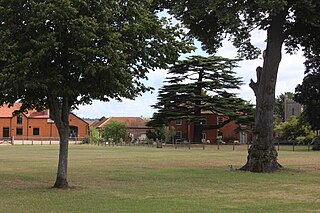
Henley-on-Thames is a town and civil parish on the River Thames in Oxfordshire, England, 9 miles (14 km) northeast of Reading, 7 miles (11 km) west of Maidenhead, 23 miles (37 km) southeast of Oxford and 37 miles (60 km) west of London, near the tripoint of Oxfordshire, Berkshire and Buckinghamshire. The population at the 2021 Census was 12,186.

Fawley is a village and civil parish in Wycombe district in the south-western corner of Buckinghamshire, England. It is on the boundary between Buckinghamshire and Oxfordshire, about seven miles west of Great Marlow and north of Henley-on-Thames.

Sir Bulstrode Whitelocke was an English lawyer, writer, parliamentarian and Lord Keeper of the Great Seal of England.

Sir James Whitelocke SL was an English judge and politician who sat in the House of Commons between 1610 and 1622.
Phyllis Court is a building that currently houses a private members club in Henley-on-Thames, Oxfordshire, England, situated by the River Thames.

Temple Island is an eyot in the River Thames in England just north (downstream) of Henley-on-Thames, Oxfordshire. The island is on the reach above Hambleden Lock between the Buckinghamshire and Berkshire banks, and is part of Remenham in Berkshire. The main significance of the island is that it lies at the start of the course for Henley Royal Regatta.

Remenham is a village and civil parish on the Berkshire bank of the River Thames opposite Henley-on-Thames in southern England. It is particularly well known for the steep approach, known as Remenham Hill or White Hill, into Henley.

Hardwick House is a Tudor house on the banks of the River Thames on a slight rise at Whitchurch-on-Thames in the English county of Oxfordshire. It is reputed to have been the inspiration for E. H. Shepard's illustrations of Toad Hall in the book The Wind in the Willows by Kenneth Grahame, although this is also claimed by Mapledurham House, Fowey Hall Hotel, Foxwarren Park and Fawley Court.

Henley Park is a country house and landscape garden in Bix and Assendon civil parish in the Chiltern Hills of South Oxfordshire, England. The house is about 1.5 miles (2.4 km) north of Henley-on-Thames. The park adjoins the county boundary with Buckinghamshire.
Stiff Leadbetter was a British architect and builder, one of the most successful architect–builders of the 1750s and 1760s, working for many leading aristocratic families.

Sambrooke Freeman FRSA was a member of the prominent Freeman family of Fawley Court near Henley-on-Thames, England. He was a Member of Parliament, for Pontefract in Yorkshire from 1754–61 and Bridport in Dorset from 1768–74.
Sambrook or Sambrooke may refer to:

Castle Ashby, often Castle Ashby House is a country house at Castle Ashby, Northamptonshire, England. It is one of the seats of the Marquess of Northampton. The house, church, formal gardens and landscaped park are Grade I listed.

St Mary the Virgin's Church is in centre of the village of Fawley, Buckinghamshire, England. It is an active Anglican parish church on the deanery of Wycombe, the archdeaconry of Buckingham, and the diocese of Oxford. Its benefice has been united with those of five other local churches to form the benefice of Hambleden Valley. The church is recorded in the National Heritage List for England as a designated Grade II* listed building.

Foots Cray Place was one of the four country houses built in England in the 18th century to a design inspired by Palladio's Villa Capra near Vicenza. Built in 1754 near Sidcup, Kent, Foots Cray Place was demolished in 1950 after a fire in 1949. Of the three other houses in England, Nuthall Temple in Nottinghamshire was built 1757 and demolished in 1929; the other two survive: Mereworth Castle and Chiswick House, both now Grade I listed buildings. A modern fifth example, Henbury Hall, was built near Macclesfield in the 1980s. Another example of a similar structure in England is the Temple of the Four Winds at Castle Howard, which is a garden building not a house.

Sir William Whitelock KC was an English barrister and Tory politician. His name is also spelt Whitelocke and Whitlock.

Foxwarren Park, at Wisley in Surrey, is a Victorian country house and estate. On sandstone Ockham and Wisley Commons, it was designed in 1860 by the railway architect Frederick Barnes for brewing magnate and MP, Charles Buxton. It is a Grade II* listed building.

Józef Jarzębowski was a Polish-born Roman Catholic priest, member of the Marian Fathers. He was an educationalist, historian, writer and noted antiquarian.

Divine Mercy College is a former Roman Catholic independent secondary boarding school for boys in the English county of Buckinghamshire. It was co-founded in 1953 by rev. Józef Jarzębowski of the Marian Fathers with lay members of the Polish community in Great Britain with the intention of providing an education that combined a British curriculum with Polish language, culture and history for the children of Polish displaced persons resettled in the United Kingdom. A Charitable foundation was formed to purchase, with a mortgage, the Grade I listed 17th-century country house with out-buildings and a park designed by Capability Brown on the banks of the River Thames. The property had been used by the British Army during the Second World War and had been vacated since.

Sir Thomas Byron was a Royalist officer during the First English Civil War. He had effective command of the Prince of Wales' cavalry regiment during the first year of the war, including at the Battle of Edgehill in late 1642. A few months later he led a charge during the Battle of Hopton Heath after the death of the Earl of Northampton, which helped the Royalists capture enemy artillery pieces. Byron was attacked by one of his own soldiers over a pay dispute in December 1643, and died from his wounds on 5 February 1644.






















